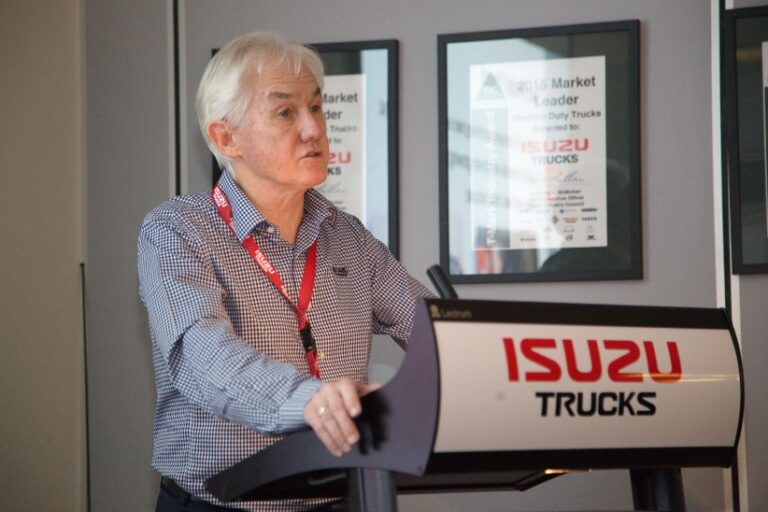Despite an illusion of relative calm, Australia’s road transport industry is undergoing a seismic operational shift, one it’s been underprepared for, according to Isuzu Australia Limited’s Director and Chief Operating Officer, Phil Taylor.
Mr Taylor believes the historic lethargy in Australia’s take-up of two-pedal operated trucks has contributed to a stifling labour shortfall within the industry. And the statistics are as surprising as they are daunting.
Needs and solutions
Australia’s freight task is set to triple by 2050, a prediction that is generating an all but unquenchable thirst for a stable and flexible driver workforce.
“I get the same shocked reaction every time I talk to people outside the transport industry about Australia’s freight task projections, and to be honest, their reactions are warranted,” Mr Taylor said.
“Short-haul metro freight is showing a particularly dramatic increase. It already stands at 28 per cent of the total national freight task, so it’s not over-stating things to suggest that we, as manufacturers and as an industry, have a genuine battle on our hands to meet growing demand.”
Mr Taylor suggests that we must continue to match needs with solutions, and one simple option is the phase-out of the clutch pedal at the lighter end of the market – an adjustment which will drastically lengthen the list of potential employees for Australian businesses.
“We’ve witnessed, and indeed reacted to, the two-pedal trend as it’s swept across Australia’s automotive markets, but unlike the Americans and Europeans, it’s taken far too long for Australia to adjust.” Mr Taylor said.
State of play
Whilst there’s a clear need to adapt to growth, Bankwest industry statistics nonetheless lend weight to the buoyant state of the broader industry, with annual employment growth recorded at over 14 per cent in late 2015. Total employment in road transport stands at over 185,000 people and the industry generated just under $52 billion dollars over 2014-15.
Contributing factors
There are numerous factors feeding into the growth of the light-duty, two-pedal market, one example being the ever-developing online shopping sector.
A recent NAB Sales Index Report reveals year-on-year growth in the burgeoning online shopping sector of 13.5 per cent, with a current value of $20.1 billion dollars per annum.
“Consumers are highly informed and they demand immediacy in their transactions. The simple fact is, this shift in consumer behaviour brings with it a critical need for easy to operate light trucks and more drivers to operate them,” Mr Taylor said.
Mr Taylor said it was figures like these that reinforce the need for a re-think of what type of vehicles and labour force are undertaking that ‘last mile’ urban delivery task. In reflecting on the state of the light-duty segment, the numbers prove there’s been some response to demand.
“There’s been very strong growth in the light truck segment in recent times. The segment has shown the strongest growth in the last couple of years, jumping to over 12,000 registrations in 2015.”
Drilling deeper into the stats, Mr Taylor says Truck Industry Council (TIC) figures reveal that just over 55 per cent of light-duty trucks sales year to date have been of the two pedal variety.
“This is up over seven per cent of last year’s figure and up 16 per cent on 2013 two pedal sales,” he said.
“These TIC numbers prove we’re on the right track, but whilst the numbers are good, there’s a raft of other factors that highlight the need for even more two-pedal light trucks, and more drivers to operate them.”
The task
Whilst the segment is developing well, research shows it is light trucks that are performing the key role in moving freight in our urban environments.
A recent AustRoads survey found that light commercial vehicles (including vans, utes and light trucks) made up 20 per cent of all vehicle types on our roads. And, of that 20 per cent, light trucks accounted for only three per cent in the four Australian cities surveyed.
Strikingly, for such a modest percentage of the total road traffic, the survey demonstrated that light trucks are almost singlehandedly performing the lion’s share (77.3 per cent) of the urban freight task.
“This demonstrates very clearly the task at hand, and the need for a sharper focus for manufacturers on ‘ease of use’ and overall ‘accessibility’ when it comes to product development,” Mr Taylor said.
“Whilst Australia has slowly cottoned-on to the two-pedal trend, we have a way to go before we see the sort of take-up rate that we need to ensure industry labour demands are met.
“We must ensure that driving trucks is a genuine and secure career path for prospective employees and employers, and part of that journey starts with the product and its applicability to the end user.
“There’s a patchwork of other issues feeding into Australia’s driver shortage, but without some considered thought at this base level, we’re doomed to be forever reactionary.”
AT A GLANCE
- Australia’s freight task set to triple by 2050
- Short-haul metro freight 28 per cent of total national freight
- Road transport total employment: 185,000 and the industry generated just under $52 billion dollars over 2014-15
- 55 per cent of light-duty trucks sales year-to-date have been two-pedal
- Light commercial vehicles make up 20 per cent of vehicles on our roads – 3 per cent are light trucks
- Light trucks performing a huge 3 per cent of the domestic urban freight task






